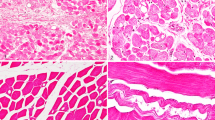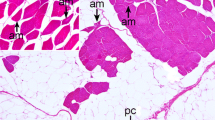Abstract
Three adult Holstein-Friesian dairy cows (4 to 6 years old) which had been raised at three different farms were culled with a long history of locomotor dysfunction attributed to dislocation or subluxation of the hip joint (two cows) or foot rot (one cow). They revealed dark brown discoloration of multiple sites of the carcasses at postmortem examination. On histopathological and histochemical investigations, lipofuscin pigments showing autofluorescence, sudanophilia, argyrophilia, periodic acid-Schiff (PAS) positiveness, and acid fastness were stored within otherwise normal cells of various sites in the body, including many thoracic and abdominal viscera, skeletal muscle, diaphragm, and tongue. In the central nervous system, some neurons with massive lipofuscin deposition were prominently shrunken but associated with neither necrotic changes nor glial reaction. Such a generalized pigmentary condition was distinguished from neuronal ceroid lipofuscinosis and thus was diagnosed as generalized lipofuscinosis. Furthermore, distinct proteinaceous eosinophilic inclusions were simultaneously observed to a varying degree within myofibers of the diaphragm, heart, rumen, or small intestine. These inclusions stained weakly positive with PAS and negative with Nile blue, Sudan black B, periodic acid-methenamine silver (PAM), and acid-fast stains. Autofluorescence was not seen. Staining properties demonstrated by phosphotungstic acid-hematoxylin (purple blue) and Masson’s trichrome (bright red) stains were compatible with those of myofibrils, presumably suggesting that the inclusions have chemical composition similar or identical to that of myofibrils. It remains to be elucidated whether the occurrence of such sarcoplasmic inclusions was related to lipofuscinogenesis or a nonspecific phenomenon indicating an incidental finding.









Similar content being viewed by others
References
Agerholm JS (2007) Inherited disorders in Danish cattle. Acta Pathol Microbiol Immunol Scand 115(Suppl 122):1–76
Agerholm JS, Christensen K, Nielsen SS, Flagstad P (2009) Bovine renal lipofuscinosis: prevalence, genetics and impact on milk production and weight at slaughter in Danish cattle. Acta Vet Scand 51:7
Åstrӧm KE, Adams RD (1981) Pathological reactions of skeletal muscle fibre in man. In: Walton J (ed) Disorders of voluntary muscle. Churchill Livingstone, Edinburgh, pp 151–208
Barker IK, van Dreumel Palmer N (1993) The intestine. In: Jubb KVF, Kennedy PC, Palmer N (eds) Pathology of domestic animals, 4th edn. Academic Press, San Diego, pp 74–141
Bialas M, Demczuk S, Dyduch G, Drabik G, Chrupek M, Okon K (2013) Brown bowel syndrome (intestinal lipofuscinosis)—a case report and review of the literature. Pol J Pathol 64:228–231
Bildfell R, Matwichuk S, Mitchell S, Ward P (1995) Neuronal ceroid-lipofuscinosis in a cat. Vet Pathol 32:485–488
Borras D, Ferrer I, Pumarola M (1999) Age-related changes in the brain of the dog. Vet Pathol 36:202–211
Bradley R, Duffell SJ (1982) The pathology of the skeletal and cardiac muscles of cattle with xanthosis. J Comp Pathol 92:85–97
Bradley R, Fell BF (1981) Myopathies in animals. In: Walton J (ed) Disorders of voluntary muscle. Churchill Livingstone, Edinburgh, pp 824–872
Brunk UT, Terman A (2002a) The mitochondrial-lysosomal axis theory of aging: accumulation damaged mitochondria as a result of imperfect autophagocytosis. Eur J Biochem 269:1996–2002
Brunk UT, Terman A (2002b) Lipofuscin: mechanisms of age-related accumulation and influence on cell function. Free Radic Biol Med 33:611–619
Carpenter S (2001) Muscle pathology on semithin resin sections. In: Karpati G, Hilton-Jones D, Griggs RC (eds) Disorders of voluntary muscle, 7th edn. Cambridge University Press, Cambridge, pp 238–295
Cesta MF, Mozzachio K, Little PB, Olby NJ, Sillls RC, Brown TT (2006) Neuronal ceroid lipofuscinosis in a Vietnamese pot-bellied pig (Sus scrofa). Vet Pathol 43:556–560
Duffell SJ, Edwardson R (1978) Xanthosis in cattle. Vet Rec 102:269–270
Friede RL (1989) In: Developmental neuropathology. Springer-Verlag, Berlin, pp 448–460
Goebel HH, Sharp JD (1998) The neuronal ceroid-lipofuscinoses. Recent advances. Brain Pathol 8:151–162
Goedegebuure SA, Hartman W, Hoebe HP (1983) Dystrophy of the diaphragmatic muscles in adult Meuse-Rhine-Yssel cattle: electromyographical and histological findings. Vet Pathol 20:32–48
Hafner S, Flynn TE, Harmon BG, Hill JE (2005) Neuronal ceroid-lipofuscinosis in a Holstein steer. J Diagn Invest 17:194–197
Haltia M (2003) The neuronal ceroid-lipofuscinoses: from past to present. Biochim Biophys Acta 1762:850–856
Harper PA, Walker KH, Healy PJ, Hartley WJ, Gibson AJ, Smith JS (1988) Neurovisceral ceroid-lipofuscinosis in blind Devon cattle. Acta Neuropathol 75:632–636
Hayward AH (1978) Xanthosis, an abnormal pigmentation of cattle. Vet Rec 102:96–97
Hӧhn A, Grune T (2013) Lipofuscin: formation, effects and role of macroautophagy. Redox Biol 1:140–144
Innes JRM, Saunders LZ (1962) Comparative neuropathology. Academic Press, New York and London, pp 147–243
Jolly RD, Douglas BV, Davey PM, Roiri JE (1995) Lipofuscin in bovine muscle and brain: a model for studying age pigment. Gerontol 41(Suppl 2):283–293
Jolly RD, Martinus RD, Shimada A, Fearnley IM, Palmer DN (1990) Ovine ceroid-lipofuscinosis is a proteolipid proteinosis. Can J Vet Res 54:15–21
Jolly RD, Palmer DN, Dalefield RR (2002) The analytical approach to the nature of lipofuscin (age pigment). Archiv Gerontol Geriatr 34:205–217
Jolly RD, Walkley SU (1997) Lysosomal storage diseases of animals: an essay in comparative pathology. Vet Pathol 34:527–548
Jubb KVF, Huxtable CR (1993) Cytopathology of nervous tissue. In: Jubb KVF, Kennedy PC, Palmer N (eds) Pathology of domestic animals, 4th edn. Academic Press, San Diego, pp 292–309
Macdonald RD, Engel AG (1969) The cytoplasmic body: another structural anomaly of the Z disc. Acta Neuropathol 14:99–107
Martinus RD, Harper PA, Jolly RD, Bayliss SL, Midwinter GG, Shaw GJ, Palmer DN (1991) Bovine ceroid-lipofuscinosis (Batten’s disease): the major component stored is the DCCD-reactive proteolipid, subunit C of mitochondrial ATP synthase. Vet Res Commun 15:85–94
McGavin MD (1995) Muscle. In: Carlton WW, McGavin MD (eds) Thomson’s special veterinary pathology. Mosby, St. Louis, pp 393–421
Nagashima N (1970) Inclusion bodies in denervated skeletal muscles of mice. Nagoya J Med Sci 33:189–202
Oberhuber G, Pointner R, Lauer E, Waldenberger P, Radaszkiewicz T (1989) “Brown bowel” syndrome—lipofuscinosis of the intestine as a cause of atonia. Leber Magen Darm 19:270–274
Porta EA (2002) Pigments in aging: an overview. Ann N Y Acad Sci 959:57–65
Schmidt U (1974) Generalized lipofuscinosis in a cat. Berl Munch Tierarztl Wochenscr 87:70–73
Terman A, Brunk UT (1998) Lipofuscin: mechanisms of formation and increase with age. Acta Pathol Microbiol Immunol Scand 106:265–276
Terman A, Brunk UT (2003) Aging and lysosomal degradation of cellular constituents. In: von Zglinicki T (ed) Aging at the molecular level. Kluwer Academic Publications, Netherlands, pp 233–242
Terman A, Brunk UT (2004) Lipofuscin. Int J Biochem Cell Biol 36:1400–1404
Tohma H, Hepworth AR, Shavlakadze T, Grounds MD, Arthur PG (2011) Quantification of ceroid and lipofuscin in skeletal muscle. J Histochem Cytochem 59:769–779
Url A, Bauder B, Thalhammer J, Nowotny N, Kolodziejek J, Herout N, Fürst S, Weissenböck H (2001) Equine neuronal ceroid lipofuscinosis. Acta Neuropathol 101:410–414
Van Vleet JF, Valentine BA (2007) Muscle and tendon. In: Maxie MG (ed) Jubb, Kennedy, and Palmer’s pathology of domestic animals, 5th edn. Elsevier Saunders, Edinburgh, pp 185–280
Wisniewski KE, Kida E, Golabek AA, Kaczmarski W, Connell F, Zhong N (2001) Neuronal ceroid lipofuscinoses: classification and diagnosis. Adv Genet 45:1–3
Conflict of interest
The author has no any financial and personal relationships with other people or organizations that inappropriately influence this work.
Author information
Authors and Affiliations
Corresponding author
Rights and permissions
About this article
Cite this article
Ohfuji, S. Bovine generalized lipofuscinosis and sarcoplasmic inclusions: histopathological and histochemical features in three cases. Comp Clin Pathol 24, 1237–1244 (2015). https://doi.org/10.1007/s00580-015-2066-3
Received:
Accepted:
Published:
Issue Date:
DOI: https://doi.org/10.1007/s00580-015-2066-3




